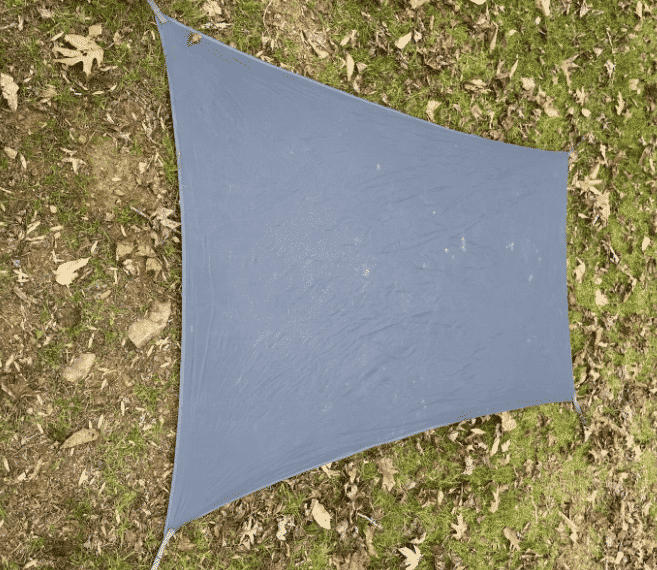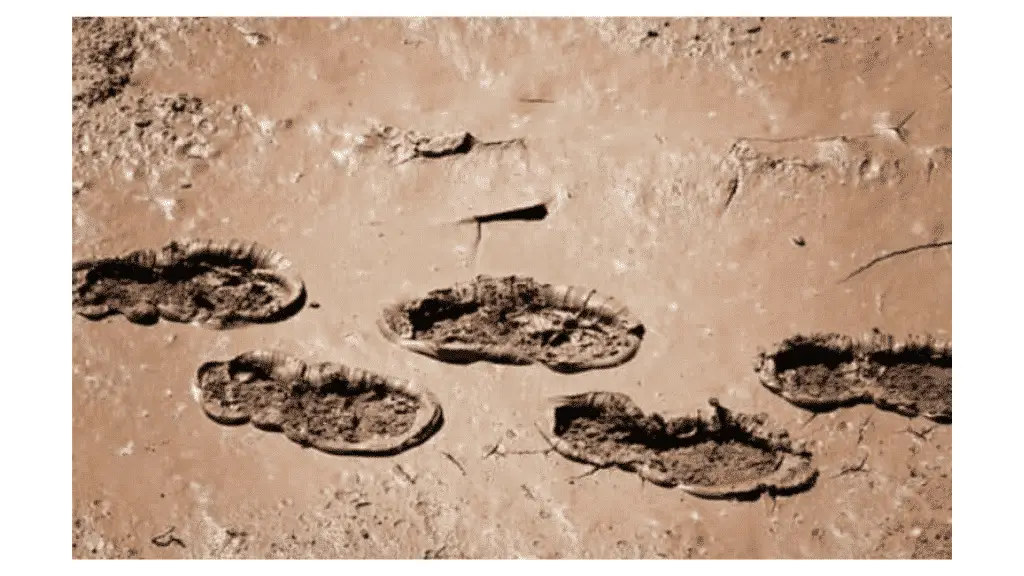Floorless tents were all the rage before I was born and it looks like they’re making a comeback in the ultralight backpacking and hunting communities. There are a few reasons why people tend to avoid floorless tents, but the main reason is that they’re afraid of water leaking into the tent. Are you doomed to get soaked in a floorless tent or can you keep the inside dry with a little bit of basic planning?
How do floorless tents stay dry? Keeping the inside of your floorless tent dry is fairly simple. All tents are designed to divert water away from the tent, but you have to be careful of where you set up camp. Try to pitch the tent on flat ground away from valleys, hills, and depressions so you won’t end up with water pooling and running through the inside your tent. Visualize your surroundings and setup camp on raised ground so rainwater diverts around your campsite and doesn’t pool beneath the tent.
That may sound simple enough, but finding a suitable location to set up camp can be somewhat tricky. You may end up flooding your campsite a few times at first, but you’ll figure it out with a little bit of practice. Here are a few tips for keeping a floorless tent dry.
How To Keep A Floorless Tent Dry
Keeping the inside of a floorless tent dry is easier said than done. Finding the right location for camp is the most important step. The key to setting up camp is to avoid low spots and watch for nearby hills that may divert water towards your tent.
In my early days of camping I’ve gotten burned by poor site selection, but you learn fast after a few cold/wet miserable nights. It might take a few bad trips, but you’ll eventually learn to avoid wet areas. Packing up after a night of rain and seeing pooling water everywhere and the dry ground beneath your tent is a great feeling.
In the real world, you will rarely find the “PERFECT” location for camp, but most ground will absorb a decent amount of water and tents are designed to divert water away from the inside. So as long as you avoid low points where the water will pool you should be OK in most storms.
Look for a camp site away from low spots where the ground slopes away from you. This means, no setting up camp in valleys, on the sides of hills, near creek beds, or minor depressions. You can usually tell where water settles/flows with a quick visual inspection of your surroundings.
Just remember that this is a learning process. It’s never fun to sleep in a wet sleeping bag, but you’ll get better at picking out camp sites along the way. You might be wet, cold, and miserable a few times, but you’ll survive and know to avoid that problem the next time.
Put Down A Tent Footprint or Tarp

Some ultralight guys like to set their sleeping pad/bag directly on the ground, but that’s beyond my comfort level. It might work in the dry summer months, but you’re asking for trouble in the spring/fall. What happens if it rains on your first night and you have to hike to a new campsite where the grounds wet and muddy? Do you really want to set your gear in the mud and get everything wet and dirty?
That’s why I always carry a small tarp or tent footprint to place under my sleeping pad/bag and keep my gear off the ground. The tarp doesn’t even have to cover the entire floor of your tent. I actually like to leave half of the tent open so there’s a dry/dirty side and clean side. Just walk in with your dirty boots and step over to the dry area. Just cut a cheap 4×8 tarp
I carry a cheap 59″x86″ Terra Hiker Tent Footprint to go under my sleeping area. It’s big enough to have a about a foot on the end and one side of my sleeping bag. My pack goes by my feet at the end of my sleeping bag and there’s like 2ft next to my bag to maneuver around and get dressed without stepping in the grass. You can also lay down a cheap tarp, but they’re bulky and hard to fold.
Just make sure the footprint doesn’t extend outside your tent walls. Tent footprints are waterproof so you don’t want water to land on it, pool up and flow into the tent.
Consider Carrying An Ultralight Cot

The ultralight community may frown at this suggestion, but carrying an ultralight cot will keep your sleeping bag/pad up off the ground and out of leaking water. Ultralight cots are really popular with hunters. They use the cot to get their sleeping gear up off the ground and put the rest of their gear on a waterproof tarp. This isn’t entirely necessary with proper campsite placement, but it does allow you to make setup errors without soaking your gear.
There are lots of different companies that make lightweight cots, but the Therm-a-rest Ultralight Cot (2lbs 9oz) is by far the lightest option I’ve seen. It holds up to 325lbs and the only downside is the price. You can find much cheaper options, but the typical ultralight cot is in the 5-6 pound range.
Watch For Signs Of Mud and Low Spots

A visual inspection of the ground should be your first step in finding low spots and drainage ditches. It can be somewhat hard to see low spots on generally flat ground, but you can usually see erosion from flowing water. Look for long straight dips in the ground going into a larger area where the water pools and drains into the soil.
You can usually tell where water drains and settles by looking at the grass. This can be a challenge in the heat of summer, but there will almost always be signs of running water and poor drainage. Water runoff will find the low spot and follow the natural flow of the ground.
Areas with heavy water flow and pooling water will almost always show signs of damage to the grass. You will see mud patches, debris that were carried with the water, damaged grass, moss growth, and possibly standing water. It really depends on what time of year it is and when the last time it rained.
Watch Out For Water Runoff
Try to visualize your surroundings and figure out the natural flow of water. Water always flows to the lowest point and follows the path of least resistance. That’s why heavily used hiking paths tend to get flooded while the surrounding area remains dry. There’s no debris in the way and compacted soil makes a natural waterway. The water will flow freely until it reaches a low spot to pool and work its way down into the water table.
You probably realize that pitching your tent in a low spot is never a good idea, but you should also watch out for free flowing water. Setting up camp halfway up a hill is a recipe for disaster. You won’t have to worry about pooling water, but water will flow through through
Think About Water Drainage

Water can usually drain through dirt and sand, but there are other areas where water really struggles to drain. There are two main areas you want to avoid when setting up a floorless tent. Watch out for sheets of stone and soil that’s filled with clay.
Stone covered soil should be fairly easy to spot since there will almost always large sheets of stone sticking out of the ground. If you see a big area of stone coming out of the earth, that usually means the surrounding area only has a few inches of dirt on top of the stone slab. Water may sink into the soil with a light rain, but there won’t be anywhere for the water to go in a downpour.
Clay filled soil is harder to spot since it’s usually mixed in with the dirt. It’s hard to describe, but you can usually tell if there’s clay in the soil when you drive your tent stakes into the ground. If the stakes go in easily and the soil crumbles apart that usually means it’s filled with sand.
Clay filled dirt will feel like you’re pushing into a pile of mud. Have you ever stepped into mud around a pond and it squishes into a clump around your shoe? That’s the same thing that will happen when you drive your tent stake into clay filled soil. It almost turns into a clumpy mud ball that you can roll around in your hands. Kind of like mud pies kids make when they’re young.
Can I Pitch A Floorless Tent At The Top Of A Hill?
You should be able to pitch your tent at the peak of a hill, but be careful of your surroundings. There will be excellent drainage at the peak of a hill, but you need to watch out for rocky ground. Water won’t drain through rock so it will divert into the surrounding area. If your tents on the path towards the hill it will be right in the way of running water.
Notice that I said you can pitch your tent at the “peak of a hill”. Don’t try to pitch your tent halfway up the side of a hill even on a flat spot. Water will flow down from the higher point on the hill and run through your tent. You probably wouldn’t have to deal with pooling water, but that doesn’t do much good when everything inside is soaked.




